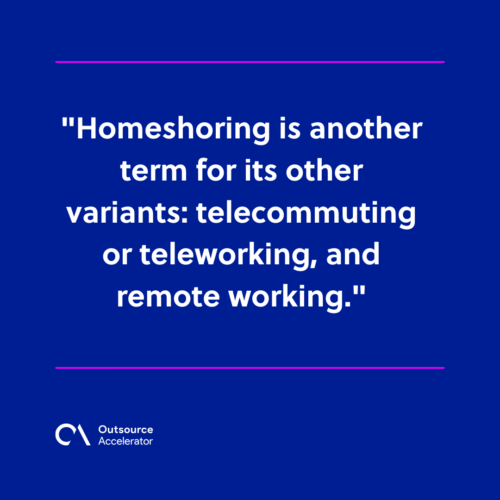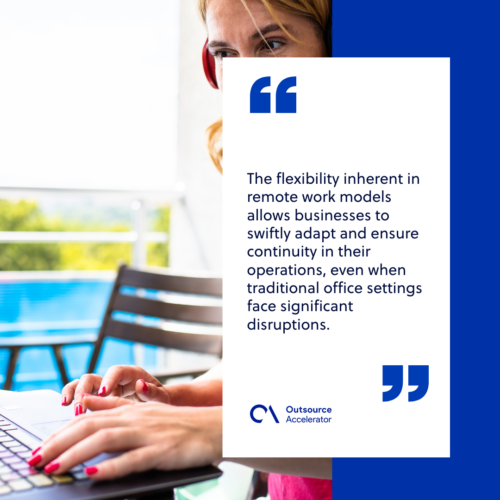The pros and cons of homeshoring

Modern work trends have fundamentally reshaped employment structures by challenging traditional norms and redefining how individuals approach their professional lives.
The beginning of remote work, flexible schedules, and diverse work arrangements have empowered workers to break free from geographical constraints.
However, these modern work arrangement trends take time and effort.
In this article, we’ll delve into the pros and cons of homeshoring and give tips on managing your remote workforce effectively.
What is homeshoring?
Homeshoring is another term for its other variants: telecommuting or teleworking, and remote working.
As we know it, it’s a practice that involves leveraging technology to enable employees to complete tasks without the need to be physically present in a traditional office setting.
Homeshoring allows remote workers to operate from the comfort of their homes, utilizing communication tools, digital platforms, and internet connectivity to fulfill their job roles.

Pros and cons of homeshoring
The typical advantages that homeshoring offers companies are access to a broader talent pool and the ability to recruit skilled professionals from diverse locations.
But beyond these, there are other unique benefits as well as drawbacks of homeshoring. Let us further explain its significant pros and cons below:
| Pros | Cons |
| Reduced commuting stress | Isolation and lack of communication |
| Customized work environment | Potential technology challenges |
| Access to global opportunities | Blurred work-life boundaries |
| Adaptability in crises | Difficulty in monitoring and management |
Pros of homeshoring
These are compelling reasons why a company might opt for homeshoring:
Reduced commuting stress
One of the primary benefits of homeshoring is the elimination of the daily commute.
Employees no longer endure the stress of traffic, long travels, or crowded public transportation, leading to increased productivity and enhanced work-life balance.
Customized work environment
Homeshoring grants remote employees the autonomy to curate their work environment according to their preferences and needs.
This flexibility also allows them to design personalized workspaces, accommodating elements that enhance their productivity and comfort.
Employees can choose their ideal lighting and seating arrangement, personalize decor, or set up ergonomic workstations.
A tailored environment contributes significantly to improved focus and efficiency.
Access to global opportunities
Geographical barriers diminish as homeshoring provides access to a global talent pool.
Employers can tap into diverse skill sets and perspectives, enriching their workforce and fostering innovation and creativity.
Adaptability in crises
Homeshoring exhibits remarkable resilience in crises, notably during pandemics or natural disasters.
The flexibility inherent in remote work models allows businesses to swiftly adapt and ensure continuity in their operations, even when traditional office settings face significant disruptions.
In times of unforeseen circumstances, such as a pandemic-induced lockdown or natural calamities causing office closures, homeshoring is a robust contingency plan.
Companies seamlessly transition their workforce to remote setups, leveraging technology to sustain workflow and productivity.

Cons of homeshoring
Now, let’s take a look at the possible hurdles of homeshoring:
Isolation and lack of communication
The absence of face-to-face interactions in homeshoring setups can lead to feelings of isolation among employees.
Communication gaps might arise, hindering collaboration, team cohesion, and the exchange of spontaneous ideas.
Potential technology challenges
Homeshoring heavily relies on technology, acting as its linchpin. While technology facilitates remote work, it also poses challenges.
Connectivity issues, software malfunctions, or cybersecurity threats are potential hurdles that can disrupt workflow and productivity. Instances like unstable internet connections or system crashes can impede communication and task completion.
Moreover, the vulnerability to cyber threats demands stringent security measures, requiring constant vigilance to safeguard sensitive information.
Blurred work-life boundaries
The absence of physical interactions poses a significant challenge—blurring the boundaries between professional responsibilities and personal life.
This lack of distinction can lead to a continuous work mode, where individuals find it challenging to disconnect, resulting in longer work hours and eventual burnout.
Difficulty in monitoring and management
Managing remote teams presents distinctive challenges, primarily from the absence of physical proximity.
The lack of in-person interaction makes it challenging for managers to gauge productivity, assess employee engagement, and provide timely support.
Tips to manage homeshoring teams
Even with the abovementioned challenges, there are still ways to strengthen your homeshoring management:
- Effective communication channels – Utilize diverse communication platforms to maintain regular contact and encourage interaction among team members.
- Establish clear expectations – Explicitly define roles, responsibilities, and performance expectations to mitigate ambiguity.
- Implement reliable technology – Invest in robust technology infrastructure and provide adequate training to tackle technological challenges effectively.
- Encourage work-life balance – Advocate for work and personal life boundaries to prevent burnout and maintain employee well-being.
- Regular check-ins and feedback – Schedule frequent check-ins to provide input and support and recognize accomplishments.
The future of homeshoring
Homeshoring presents a paradigm shift in the traditional work landscape, offering numerous benefits and significant challenges.
Effectively managing homeshoring teams necessitates robust communication strategies, technological prowess, and a keen focus on employee well-being.

Furthermore, as the future unfolds, homeshoring is poised to shape a new era of work, redefining how organizations operate and employees engage in their professional lives.







 Independent
Independent




